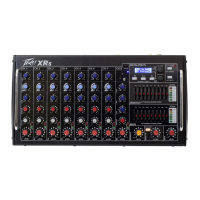
Do you have a question about the Peavey XR s and is the answer not in the manual?
The equipment complies with FCC radiation exposure limits set forth for an uncontrolled environment.
Combination input jack for balanced/unbalanced ¼” or XLR connections.
Reduces input signal by 25dB to prevent distortion and increase dynamic range.
Shelving EQ for treble frequencies to add brilliance or remove noise.
EQ with two frequencies for improved vocal/instrument definition.
Shelving EQ for bass frequencies to add depth or clean muddy sounds.
Adjusts the level of the channel signal added to the monitor send.
Adjusts the level of channel signal added to the effects mix.
Indicates signal is too strong, potentially causing distortion.
Indicates the mixer is receiving signal at the input of the channel.
Control for the channel's output signal level.
Combination input jack for balanced/unbalanced ¼” or XLR connections.
Stereo inputs for MP3 players, CD players, or other devices via RCA and 3.5mm jacks.
Selects between Mic-Line preamp or media inputs for channel 7.
RCA jacks providing a signal to recording devices.
¼” jack providing main mix signal for external power amplifiers.
¼” jack providing monitor mix signal for external power amplifiers.
¼” jack providing signals under 150Hz for subwoofers.
Applies +48 VDC to all XLR inputs for microphones requiring phantom power.
Indicates when PHANTOM POWER is activated.
Selects Main or Monitor mix signal for power amp 2.
USB connector for connecting storage devices for music playback.
Indicates the status of the Bluetooth connection: off, pairing, or connected.
Selects input for channel 8: Mic-Line (XLR), USB, or Bluetooth.
Shelving EQ for treble frequencies to add brilliance or remove noise.
Band-pass EQ for mid-range frequencies.
Shelving EQ for bass frequencies to add depth or clean muddy sounds.
Adjusts the level of the channel signal added to the monitor send.
Indicates signal is too strong, potentially causing distortion.
Indicates the mixer is receiving signal at the input of the channel.
Control for the channel's output signal level to the main mix.
Displays currently selected Effect and media input status.
Navigates and selects EFX presets and parameters.
Mutes effects to the main and monitor mix for a dry signal.
LED indicates signal sent to effects section is too high.
Rewinds to beginning of song or goes to previous song.
Toggles the current song between play and pause.
Advances to the next song or fast forwards through the current song.
Navigates through folders/songs on USB drive and cues files.
Mutes mic/line inputs across all 8 channels.
Feedback Locating System LEDs indicate feedback frequency.
Nine-band equalizers to reduce feedback or adjust frequency response.
Indicates signal level of main and monitor mix, including LIMIT.
Enriches sound with natural bass enhancement.
Toggles the EFX return signal being sent to the monitors.
Adjusts the signal level for the monitor output.
Sets the level of the main mix and overall volume.
The main power switch for the unit.
Main safety fuse for AC line voltage; replace with exact type and rating.
Receptacle for IEC line cord providing AC power.
Selects between 115VAC/60Hz or 230VAC/50Hz.
Speakon/¼” jacks for connecting speakers to Power Amp 1 (Main Mix).
Speakon/¼” jacks for connecting speakers to Power Amp 2 (Main or Monitor Mix).
¼” TRS jack for footswitch to defeat effects or activate Mic Mute.
Plate reverb parameters: Description, Predelay, Damp Factor, Room Size.
Hall reverb parameters: Description, Predelay, Room Size, Front/Back End.
Room reverb parameters: Description, Predelay, Room Size, EQ, etc.
Delay parameters: Double, Slapback, Bright/Dark Repeats.
Enhancer parameters: Light, Moderate, Heavy Harmonics.
Chorus parameters: Depth, Rate, Modulation Type.
Mic and Line input sensitivity levels at full and nominal power.
Master equalizer frequency response adjustments.
Channel equalizer shelving EQ for Low, Mid-Morph, and High frequencies.
Clip LEDs indicate signal clipping 3 dB before actual clipping.
Frequency response across different signal paths and controls.
Specification for phantom power supply.
Noise floor specifications for main and amplifier outputs.
Total Harmonic Distortion specifications.
Meter array specifications for signal level and limit.
Function of the amplifier limiter.
Output power ratings for amplifier channels at different impedances.
Power consumption and voltage requirements for domestic and export.
Physical dimensions of the mixer unit.
Weight of the mixer unit.